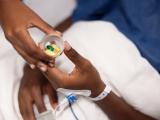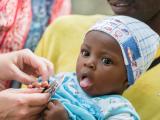A randomized clinical trial conducted in Finland found that point-of-care testing for respiratory pathogens did not reduce the use of antibiotics in a pediatric emergency department (ED), researchers reported yesterday in JAMA Network Open.
The trial, which included more than 1,200 children, was investigating whether the use of a multiplex polymerase chain reaction (PCR) point-of-care test that can detect respiratory viral and bacterial pathogens would reduce antibiotic prescribing in acutely ill children treated in a pediatric ED. Because the causes of respiratory tract infections in children are often difficult to determine based on symptoms, antibiotic use among children is high—and often unnecessary.
Previous research has shown, however, that rapid tests for flu and other respiratory viruses can reduce antibiotic use in pediatric emergency settings. Based on that evidence, the trial investigators hypothesized that a multiplex point-of-care PCR test would have a similar effect.
But that wasn't what they found.
More than a fourth got antibiotics, regardless of testing
Conducted in the pediatric ED of a Finnish university hospital from March 2019 to March 2020, the trial included children ages 0 to 17 who had a fever and/or any respiratory signs or symptoms, including rapid breathing, shortness of breath, apnea (disruption of breathing), cough, wheezing, rhinitis (inflammation in the nose), sneezing, croup, earache, or sore throat.
The participants were randomly assigned 2:1 to undergo either multiplex PCR point-of-care testing upon arrival at the pediatric ED, with results available in 70 minutes, or receive routine care.
The children in the intervention group were tested for 18 respiratory viruses or viral subtypes and 3 bacterial pathogens. Those in the control group were tested only if the ED physician determined it was necessary, with results available the next day. The primary outcome was the proportion of children with any antibiotic started in the ED. Secondary outcomes included the number of diagnostic tests and radiographic imaging procedures performed and costs associated with the ED visit.
Of the 1,243 children included in the intention-to-treat population, 829 were assigned to the intervention group and 414 to the control group. The mean age of children in both groups was 3 years, and 56% of participants were boys. Of the children in the control group, 258 (62.3%) underwent multiplex PCR testing at the direction of the ED physician.
Overall, there was no significant difference in the proportion of children who received antibiotics in the two groups (226 children in the intervention group [27.3%] vs 118 children in the control group [28.5%]; risk ratio [RR], 0.96; 95% confidence interval [CI], 0.79 to 1.16). The indications for prescribing antibiotics were mostly concordant with Finnish national guidelines. The number of diagnostic tests or instances of radiographic imaging did not differ between the two groups, nor did cost.
An exploratory analysis found that the proportion of children who received untargeted antibiotic therapy was also similar in both groups (25.8% in the intervention group vs 28% in the control group; RR, 0.92; 95% CI, 0.76 to 1.12). But pathogen-targeted antibiotic therapy was higher in the children in the intervention group than those in the control group (1.4% vs 0.5%; RR, 3.0; 95% CI, 0.76 to 11.9).
"Systematic testing for respiratory pathogens in the ED appears to have a limited impact on clinical decision-making regarding antimicrobial therapy for acutely ill children," the investigators, from the University of Oulo, concluded.
Interpreting findings with caution
The study authors say the findings, however, should be interpreted with caution. For one, many of the children in the control group also received rapid testing for flu and respiratory syncytial virus (RSV), which may affect the outcome. They suggest the effect of the intervention could be different in EDs with less diagnostic testing for respiratory pathogens.
In addition, they note that Finland is a high-income country with a low rate of antibiotic consumption, and that it is unknown whether point-of-care testing for respiratory pathogens may reduce antibiotic use in pediatric EDs in countries with different antibiotic prescribing attitudes and policies.























